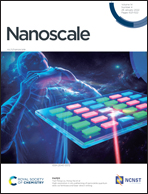Identification and optimization of tunable endosomal escape parameters for enhanced efficacy in peptide-targeted prodrug-loaded nanoparticles†
Abstract
Endosomal escape of nanoparticles (NPs) is a weighty consideration for engineering successful nanomedicines. Although it is well-established that incorporation of histidine (His) in particle design improves endosomal escape for NPs, our understanding of its effects for ligand-targeted nanoparticles (TNPs) remains incomplete. Here, we systematically evaluated the cooperativity between targeting ligands and endosomolytic elements using liposomal TNPs with precise stoichiometric control over functional moieties (>90% loading efficiency). We synthesized endosomolytic lipid conjugates consisting of 1 to 10 consecutive His residues presented at the end of linkers between 2 to 45 repeating units of ethylene glycol (Hisn-EGm). Hisn-EGm had minimal effect on NP size (∼115 nm) and had no significant effect on the receptor specificity of TNPs (>90% inhibition by competing peptide). We evaluated various formulations with 8 different targeting ligands relevant to two disease models. Incorporation of His1-EG8 resulted in up to ∼170- and ∼12.9-fold enhancement in intracellular accumulation relative to non-endosomolytic NP and TNP, respectively. These observations were time-dependent, targeted receptor-dependent, and showed different trends for NPs and TNPs. Further evaluation demonstrated short linkers (EG2–4) significantly enhanced nanoparticle internalization compared to EG8 or longer by up to ∼2.5-fold. Finally, rationally optimized formulation, His1-EG2-TNP, improved in vitro toxicity of a DM1 prodrug to SK-BR-3 cells by ∼4.2-fold, with IC50 ∼8.5 nM compared to ∼36 nM for no-His TNP, and >100 nM for non-targeted/no-His NP. This study uncovers an intricate relationship between endosomal escape and ligand-targeted drug delivery, as well as tunable parameters. Furthermore, our findings highlight the value of rational design and systematic analysis for optimization of multifunctional NPs.



 Please wait while we load your content...
Please wait while we load your content...